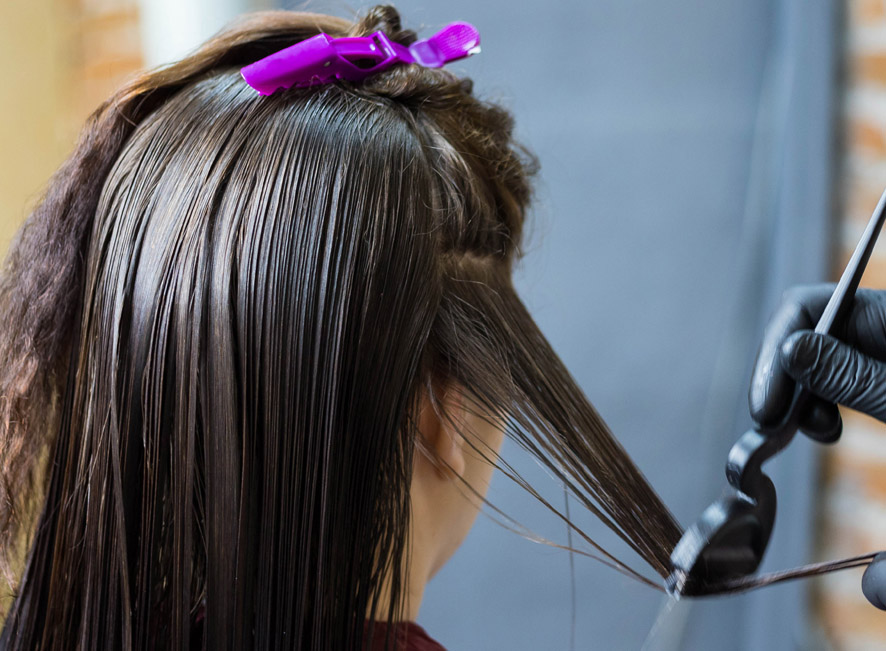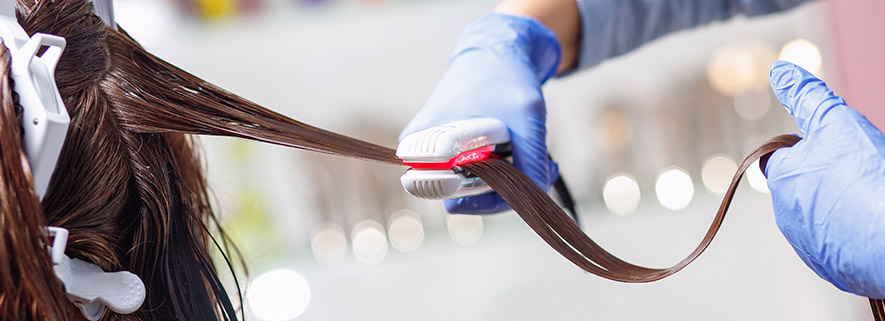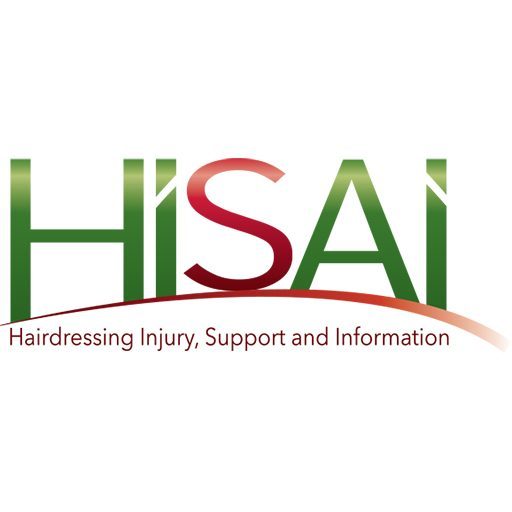Chemical Straighteners / Relaxers

Modern hair relaxers and perms can often be made of the same chemicals, just applied differently.
(There is a separate section for ‘lye straighteners’ below.)
The basic theory of either creating a permanent curl or straightening hair permanently is the same.
- Stretch the hair into the shape you want with tension; this could be over a rod or barrel if you wish to a curl or combing the hair straight when the product is applied to create a straight tension.
- Apply a chemical to break the disulphide bonds in the hair to soften the hair enough to keep the tension shape.
- Apply another product to stop the softening and so keeping the hair in its new shape.
Straightening products usually use ammonium thioglycolate or ATG); however, there are other types; it is essential to know what type was used:
Thio Relaxers
Thio relaxers and perms use ammonium thioglycolate (ATG); the straightening products are usually at a much higher pH and concentration than perm lotions.
These relaxers are also thicker with higher viscosity or thickness, which makes for an easier relaxer application.
Thio relaxers and perms break the disulphide bonds in hair, like the permanent waving process. When enough of the disulphide bonds are broken, the relaxer is rinsed from the hair, and the hair is towel dried. After towel drying, a neutraliser of some sort is applied to the hair.
Ammonium thioglycolate is also known as perm salt for its use in permanent waves. Perm salt is a chemical reducing agent which selectively weakens the hair’s disulphide bonds instead of disrupting the entire protein but strips out the natural oils even more thoroughly than the alkali hydroxide products. Afterwards, the thioglycolate must be oxidised with a usually with a solution of hydrogen peroxide.
Alkaline & Lye Relaxers
A lye relaxer consists of sodium hydroxide (also known as NaOH or lye). On application, the caustic “lye cream” permeates the hair’s protein structure and weakens its internal bonds by breaking the disulphide bonds, causing the natural curls to loosen out as the entire fibre swells open.
No particular deactivation step is required after washing the lye cream out, except routine pH adjustment and hair-conditioning. This causes some broken disulphide bonds to reform but with a bond that only contains one sulphur atom. The process cannot be repeated on hair treated in this way.
The level of the hydroxide in these products is limited by the EU and UK Cosmetic Regulations to a maximum of 2% in products for general use and 4.5% in products for professional use. There are also mandated warnings that need to be applied to the product. In extremis these products can cause blindness. The pH of the product is usually high up to 14.
Base & No Base Formulas
Entirely distinct from the chemical concept of base as a broader definition for “alkaline”, lye relaxers may be labelled as “base” or “no base”. In this instance, the “base” refers to a preliminary coating of petroleum jelly onto the scalp to protect it from being irritated or burned by the lye cream.
“No base” creams have a lower lye concentration and may be applied directly to the hair roots without requiring the protective “base” layer. However, these weaker products may still irritate some people’s skin who must therefore coat their scalps beforehand anyway.
No Lye Relaxers
No-lye” operates on the same general principle as lye relaxers but uses different chemical agents, such as potassium hydroxide, lithium hydroxide, or guanidine hydroxide (marketed as gentler to the hair but still requiring care in use).
The last of these is not pre-formulated but rather is generated at the time of use by combining a cream containing calcium hydroxide (slaked lime) with an “activating solution” of guanidine carbonate.
Lastly, the active agents of most relaxers sold for home use are ammonium sulphite and ammonium bisulfite (the two compounds are interchangeable, depending on the product pH). These also selectively reduce the disulphide bonds but are much weaker and work more slowly (the bonds are reformed by exposure to the air). Nevertheless, their mild action minimises (but does not eliminate) collateral irritation to the skin but also limits to effects of the products which do not work well on strong curly hair.
During the relaxing process, the hair is first washed and then sectioned for ease of application; The chemical relaxers should not be applied to the scalp as they have a high possibility of causing a skin burn.
The disulphide bonds are cleaved during the application the hair is usually mechanically straightened using a comb during this phase.
The time stated by the manufacturer for safety varies, but application time and processing time should be factored into the process together. The product starts processing once the product is in contact with the hair.
If you have your hair straightened regularly, emphasis should be only on new growth hair. Repeated treatments can lead to hair breakage, which usually occurs at the junction of the new growth and previously treated hair.
Careful application to new growth only and previous conditioning of the hair can help prevent excessive breakage.
The Japanese System
The Japanese system of straightening hair uses the same type of chemical used in perms, ammonium thioglycolate (ATG), this is a reducing agent that will soften the hair by breaking some of the disulphide bonds allowing the hair to take shape as required (in this case the hair is pulled straight). A hot iron is then applied during this process. This is the basis of the process called “Japanese hair straightening or thermal reconditioning.”
After the straightening process has taken place, the hair is then ‘hardened’ using an oxidising agent (usually hydrogen peroxide) which partially sets the hair.
This last step is sometimes called ‘reforming’ the bonds. However, this process is not perfect and not all disulphide bonds will be reformed. The straightened hair is under stress and can start to revert back to its original conformation over time. Additionally, damage may be done to the hair by the hydrogen peroxide in the neutraliser which although used at much lower concentration than in bleaches (see bleached hair damage page) can still cause some oxidative damage to the hair.
Thermal reconditioning involves the transformation of (hard) alpha-helical keratin proteins in (soft) amorphous protein and 90% of the initial cysteine content is retained with 10% additional cystine as cystic acid.
This means that using thioglycolate with heat causes less protein loss than hydroxides; theoretically, this may be better for the hair, but the added heat can also compromise the hair’s keratin, more so in its weakened state and so should still be treated with caution.
Hydroxides and thioglycolate are incompatible with each other. If the hair has been treated with a hydroxide relaxer, the same hair cannot be treated with a thioglycolate relaxer. Both are incompatible with bleached hair.
A strand test should be performed before applying the product to ensure the product’s compatibility with the hair and the result requested.
National Occupational Standards have been written for straightening and relaxing services and can be viewed via the website: https://www.ukstandards.org.uk

Keratins Blow-dry / Brazilian Blow-dry / Brazilian Keratin Treatments
The history of this product is worse than the product itself.
Initially containing high levels of formaldehyde, these products are now banned due to safety considerations; keratin blow-dries are popular as they promise non-chemical/no-damage straightening.
This statement is not precisely true. The keratin product is safe enough for hair; the product is thought to cross link the hair thus minimising the effects of water, hardening the hair, and coating the hair in a layer that is then hardened with a high temperature (which accelerates the reaction) electrical heated straightener.
The heat seals the protein coating and smooths the cuticle down and stops water from penetrating the hair as much. This is semi-permanent and must be re-applied over several months as the coating wears off.
The problem comes from the high temperatures used in sealing this product, repetitive stokes made from the electric straightener at very high temperatures (190˚C +) can melt keratin and cause irreparable hair damage. (See also heat damage).
This process rarely causes immediate breakage to hair fibres, but may cause the hair to become dry, brittle, and of poor quality.
The damage which has occurred may not be seen for several weeks or months after the process, not until the coating wears off several months later when as a treatment for dry hair, the process is repeated to alleviate the feeling of poor quality. So, the cycle may become chronic and repetitive, resulting in several destructive cycles until the hair is too damaged to be masked.
National Occupational Standards have been written for keratin blow-dry services and can be viewed
via the website: https://www.ukstandards.org.uk

